|
416 Lynx Squadron
1942-1945 with my father’s reminiscences
The 416
Squadron of the RCAF was formed in November of 1941 in Aberdeen, Scotland.
This “City of Oshawa” squadron used the images of a leaping lynx
superimposed upon a maple leaf as its emblem. Its motto “AD SALTIUM PARATUS”
translates as “Ready to Leap”. Throughout the Second World War its primary
aircraft was the Spitfire. Although disbanded after WWII in 1946, the
squadron was re-activated in 1952 surviving to this day and now piloting
CF-18 Hornet Tactical fighter jets as they did during the Gulf War in 1991.
This wee
piece contains a brief description of the squadron in the war years, the
Spitfire aircraft, and stories gleaned from a RCAF Spitfire mechanic’s
experiences; from volunteering in Ontario and during service in Scotland,
England, Normandy, France, Belgium, Netherlands and Germany.
Please
excuse the quality of the pictures within the collages but they have
weathered the course of over 60 years and have endured much along the way.
The RCAF
416 Squadron during WWII was made up predominantly of individuals trained in
the British Commonwealth Air Training Program (BCATP) which was initiated in
1939, and launched in 1940. Under this program pilots, aircraft mechanics,
navigators, radio men, logistic personnel, ground crew members and more,
were to be trained for service in the UK, Canada, Australia, and New Zealand
– all of these sites being far from the hostilities. During the following
five year period 360 schools were established at well over 200 sites across
Canada. 131,533 graduated from this program, and I believe that Canada’s
share in this program was set and achieved at near 80%. Both men and women
participated in this program with many persons from countries other than
Canada, including the United States, being accepted and trained here.
My father,
George Ruickbie, volunteered for RCAF service after completing his high
school education. Being already a half decent mechanic he was placed in the
BCATP program to become an aircraft engine mechanic. He eventually made his
way to Scotland where he became one of the early members of the 416
Squadron. Prior to starting the program he acquired a camera to “take a few
pictures” along his way. He carried this camera to Germany and home again.
While not a “pro” some of the pictures taken by him that have survived
basement floods and attic heat I think are worth sharing.
An
interesting aside: in the early years of the war the Muskoka Airport in
Bracebridge, Ontario was called “Little Norway”, where 4,000 Norwegian
airmen trained. These men, in addition to their billets in the immediate
Bracebridge area, stayed and trained in many surrounding area locations. In
fact, a number of these Norwegian airmen built a large log cabin structure,
and small out-buildings on Limberlost Road which is located between
Huntsville and Dwight (about 30 miles north of Bracebridge). This location
we currently know as “Camp Olympia”, a kids’ summer camp on Oxbow Lake.
Further, one unlucky Norwegian pilot crashed his Cornell PT-19 Fairchild in
Lake Muskoka, and recently a piece was dragged up to the surface –much to
the amazement of many.
In the
southern Ontario region one of the larger “initial” training sites used
during the BCATP was in Galt, Ontario (now Cambridge). This
school, originally opened in February of 1852, still exists as Galt
Collegiate Institute. This was where my father began his training. Many RCAF
and RCN volunteers went through the programs here.
From here
the pupils (and more than a few of the teachers) scattered across the
country to participate in the secondary training of various disciplines. In
the fall of 1941 my father proceeded to the “St Thomas No. 1 Technical
Training School” in south western, Ontario where he learned how to properly
maintain, repair and service aircraft engines. This school now is the “St.
Thomas Psychiatric Hospital”. A historical plaque currently mounted at this
site reads: “RCAF TECHNICAL TRAINING SCHOOL - The only facility of its
kind in Ontario during the Second World War, No. 1 Technical Training
School, St. Thomas was established by the Royal Canadian Air Force in 1939
to produce skilled ground crews for active wartime service. It was housed
here in this hospital complex and was operated in compliance with Canada's
commitment to establish air training facilities in sites removed from the
theatre of war. Equipped to handle more than 2000 students at a time, the
school offered six month courses for aircraft electricians and aero-engine,
airframe and instrument mechanics in addition to specialized training for
fabric and sheet metal workers. When the war ended in 1945 the school was
closed and the complex was returned to the Ontario Department of Health.”
From St.
Thomas many of the graduates went on to further “hands-on” training while
also acting as service crews on the planes used to train pilots at flight
schools set up a many locations across Ontario. My father went to No. 5
Service Training Flying School near Brantford, Ontario. This school, also
part of the BCATP program, was opened on 11 November 1940 to primarily train
bomber and transport plane pilots. No. 5 SFTS was closed in November of 1944
-three of the hangars still stand and are part of the complex that now
houses the Blue Bird Coach Lines terminal operation.
|

The “bible” for RCAF Aircraft Engine Mechanics
|
The
relating pictures1 of this period are from this Ontario training
period. Shown are a few of the training craft, a marching drill in Galt, and
my father’s mechanics group at Brantford SFTS (he’s George). The picture in
the bottom right corner is that of a twin engine trainer of theirs that was
forced to do an emergency landing, because of a mechanical problem, on a
farmer’s wheat field just outside Waterdown, Ontario.
From such
training locations these RCAF volunteers were disbursed to their various
assigned locations, with most making their way via ships sailing out of Nova
Scotia to the United Kingdom for active duty. Upon arrival at their final
destinations they were (“finally”) assigned to their squadrons or unit
locations.
Prior to
the war the RCAF forces numbered less than 5,000. By D-Day this number had
grown to near a quarter million. In 1944 the RCAF had 78 squadrons, 46 being
on active duty.
In the UK
the fresh men from BCATP-RCAF training were given additional instruction and
experience in more relative areas of their posts. Pilots trained on the
specific models of aircraft they would fly, and ground crews became more
acquainted with the engines and systems. Plus all were physically and
mentally hardened for what was ahead, being trained more thoroughly in the
use of weapons, and ways of war.
The 416
initially stationed in Scotland, began in the summer of 1942 to move
steadily south. Within this period the 416, 403, and 421 Squadrons were
brought together as the 2nd Tactical Air Force, No. 127 Wing. The
missions began in the defense of Britain.
During this
period the 127 Wing practiced moving the squadrons from place to place, over
and over, in preparation for what was coming. The day before a move, every
member of the squadron received a precise list of what they were responsible
for, and orders that they must ensure that all items made it to the far end
of the relocation (failure was not an option that should be explored). The
move would start at dawn and all had to be completed and fully set up for
operation within that day.
Initially
there was a small group of United States citizens in the 416 Squadron. These
men had volunteered for military service in Canada prior to the USA
Declarations of War. After the USAF arrived and was operational in England
the men were transferred to serve with their countrymen. Also in the 416 was
a group of six French airmen who are seen in the photos7 sitting
together in a group.
In the late
spring of 1944 the 127 Wing was operating out of RAF Station Tangmere near
Chichester, Sussex, England in preparation for the invasion.
Within the
period2 before the invasion most men did get the chance to
acquaint themselves with the United Kingdom through their regular passes.
While on leave they did manage to tour or visit never seen before relatives
in England and Scotland. But, as the invasion date became closer such jaunts
became rarer. Everyone knew an invasion may be coming, and it came without
much warning -the invasion of Europe by Allied Forces began in Normandy on
June 6th.
On D-Day
and until June 10th the entire 127 Wing, flying from Tangmere,
served to provide low altitude beach head support and patrols over Normandy
from dawn till twilight. In this period the sorties numbered about 100 per
day.
The Royal
Engineers landed at Normandy late in the day on June 6th and
within four and a half days, working around the clock, cleared and
constructed air base “ALG B2” near Bazenville. This was no easy task
considering the new airfield itself was to be almost a mile long and well
over 200 feet wide. A good portion of one end had to be backfilled
substantially to make the surface level. After leveling, the entire central
portion of the surface was covered with a heavy woven wire mesh that was
metal staked to the ground. Rolls of this steel mesh are seen in one of the
photos7 –behind the six 416 Frenchmen. This mesh provided a
stable surface in all weather conditions while minimizing erosion, rutting
and pot-holing. But this mesh did sometimes present problems when there
might be a bombing attack or landing mishap – it would get badly torn up and
lay twisted on the airfield stopping all runway use for many hours while the
damaged mesh was removed, the runway surface repaired, and new mesh
installed.
June 11th
through June 13th mixed two squadron low level armed patrol
missions were operated rather than three, with sorties making temporary use
of “B2” runway in Normandy throughout the day on June 11th.
The weather
through this period was not the best. Low ceilings, low visibility and rain
may have been the reason for the fact that on June 13th aircraft
flown by 127 Wing Commander L. V. Chadburn (who was leading the 416 Squadron
at the time) and F. Clark (a pilot from 421), collided in midair – both
Canadian men perished and now rest in peace in different graveyards only
miles from the crash site near Caen.
My father
advises that when the entire 127 Wing flew together in this time, that 403
Squadron was the lead, with 416 second, and 421 as the tail. This particular
order apparently established by the experience levels of the pilots within
each squadron.
On June 16th
the127 Wing was relocated3 to Normandy. The pilots flew their
planes to their newly constructed bases, while the ground crew made the
crossing in Dakota transport planes or on the water in troop carriers, with
their trucks and gear. My father’s group went by sea -“It was a rough ride”.
Within a
month of D-Day the 443 Squadron joined the 127 Wing increasing its size,
depth, and strength. You may recognize the 443 Squadron as that which
currently flies the “Sea King” helicopters. Today the 403 Squadron is a
Helicopter Training force. The 421 Squadron has now been disbanded. The
markings used by 403 Wolf, 416 Lynx, 421 Red Indian, and 443 Wasp units were
KH, DN, AU, and 2I respectively.
Here are
the 127 Wing Squadron emblems at its peak level:

The
Spitfire9 aircraft is sometimes called the pinnacle of evolution
of prop driven fighter planes preceding the advent of jets. It is the single
most recognizable classic fighter plane. Over 22,000 were flown during the
era of the war in all parts of the globe.
Really a
small fighter by today’s standard the plane measured approximately 31 feet
long, a bit over 12 feet tall at its highest point (prop tip), with a
wingspan of about 37 feet. It was a single engine; single seat fighter
outfitted with wing mounted machine guns and small caliber cannons. The
weight of the plane was at a trim 7,500+ pounds.
Manufactured by Supermarine, and boasting up to a 1700 horsepower
Rolls-Royce Merlin engine (or Packard in later years), the Spitfire was
capable of a comfortable cruising speed of 280 mph, with a top speed on the
flat of over 400 mph and maximum ceiling of 8 miles. Range with standard
fuel load was just over 400 miles in the true fighter models. Use of an
auxiliary “drop” tank could extend this flying range up to 200 miles. This
flight range may appear great, but do remember the speed – even with drop
tanks a return to a base for refueling would be required within several
hours of takeoff. The engine burned fuel at an average rate of about one
gallon per minute.
Initially
the Spitfire fighter models were armed with four .303 machine guns, and two
20mm Hispano cannons (120 rounds each). By D-Day these lower caliber machine
guns had been replaced by two high powered .50 Browning machine guns (250
rounds each) which had armour piercing capabilities. Most had the capability
of carrying a 250 pound bomb on each wing, plus a 500 pound bomb on its
belly. The Mark II Gyro Gun-sight used through the European campaign gave
good targeting accuracy.
With a
possible flying height of 40,000 feet, the planes were equipped with oxygen
breathing apparatus and storage tanks.
It was
small, quick, and maneuverable with a sting –a deadly combination in those
times. Imagine a hornets’ nest of these coming after you –coming down out of
the clouds at almost 400 miles per hour with quite accurate armaments
capable of permanently disabling a locomotive or armoured vehicle traveling
at full speed. All through the war the Spitfire was constantly redesigned to
improve its speed, fire power, and suitability to the many tasks it handled
over land, sea, and in the air. All of this being necessary to keep pace
with similar programs by the foe. Dozens of different models were produced,
each improving to meet the needs of the time.
All of
these planes were built light to maximize speed. Very little armour plating
was present. The pilot’s seat did have a curved bullet proof plate in its
backrest which did provide some protection.
One must
consider that the technology was not as advanced, in those times, as we
enjoy (or deplore sometimes) today. There was no on-board radar, or tracking
systems, or “smart” weapons. Just point it, get there, find a target,
attempt hitting it, and then get out as quick as possible – all the while
being watchful of those attempting to make you the target. Jet aircraft was
not available to the RCAF squadrons at this time – but the Germans used them
near the end of the war – a picture7 of a captured Heinkel jet
fighter is in the collages.
In Europe
the day-fighter models of the Spitfire served to be much more than a
suitable choice in its role to protect ground convoys, as a bomber escort,
as an armed scout aircraft, and for use in direct daylight attacks on the
enemy or to scramble to defend against incoming threats. In all, a high
contribution was made by the Spitfire, its pilots and crews, in hastening
eventual victory while minimizing losses.
The 416
Squadron flew the Spitfire Mark VB or VC early in its days, but used mostly
Mark IXC and Mark XVI models within 1944 and 1945.
The days in
Normandy were long with non stop “right-now” activity. On dry days the dust
generated on the airfield was horrendous “You couldn’t see 20 feet in front
of you” – it rose in thick clouds on every takeoff or landing, and got into,
and onto, everything, everybody, everywhere, and was a major problem at
times with the air intake systems of the aircraft engines. (After all, the
airfields were on dirt.) My father complains that the mosquitoes were at
times unbearable. The food was acceptable. There were no showers or baths
and one would have to try and make the best of it using a bucket of water,
soap and cloth.
For the 416
ground crew these days always beginning with their group leader waking them
by pounding on an empty jerry can while shouting repeatedly “Wakey, Wakey,
Wakey – Its daylight in the swamp – Time to get on the palms of your feet –
Everybody up….” Early morning was the time that most attacks on the 416 base
camps came, with the enemy hoping to catch a few planes still sitting on the
ground. But bombs did sometimes fall in darkness, and a few times without
warning in the day.
Planes were
in the air within one hour of rising. Each squadron within the 127 wing
typically had a dozen aircraft. Not all left immediately, but were staged
out quickly and selectively through the day with replacements always being
readied to take off just prior to those incoming. This activity would be
further complicated by planes from other than the 127 Wing dropping in to
refuel, rearm or repair. On top of this would be steady regular traffic of
new arrivals, supply flights, squadron planes coming home early due to
problems or out of ammo, and flights bringing in and taking out the wounded.
Then to really spice things up, in the midst of all this, the occasional
“incoming attack” warning signal would be sounded which would send the field
into a real frenzy with planes scrambling to take off and the ground forces
heading for arms and cover in the slit trenches.
Slit
trenches were located near the planes, near the men’s tents, and at other
strategic locations about the air base. These trenches being quite narrow
were deep enough to stand in while still offering protection from enemy
attacks and the shrapnel from bombs. All men slept in “sleeping trenches”
dug4 within their tents – a “very wet” situation when it rained.
But these trenches were very important at times in the early days, saving
many lives.
These
airfields would rarely remain in any one place too long. When the movement
of the Allied front accelerated towards Germany a stay of only two weeks in
one location was not unusual.
Interestingly, my father has stated that one of the most important items,
always of great concern in a move, were the Spitfire battery chargers.
Apparently, in the cold mornings of the fall and winter of 1944, little flew
without their constant use.
The allies
did eventually have air superiority due to the efficiency of the allied
pilot efforts, and by the sheer overwhelming numbers of aircraft that the
Allies had available in comparison to the Luftwaffe. It is estimated that in
June of 1944 that the number of Allied bombers and fighters available
totaled well over 8000, while the Germany numbers were well less than 400.
This did, well after D-Day as more and more planes endlessly joined the
battle, leave the 127 Wing squadrons to concentrate upon their tasks with
targets supplied by command, located by scout planes, or spotted by ground
forces seeking assistance. In the initial period what there was of the
Luftwaffe did offer great resistance with many air battles occurring in
close proximity or right over the 416 air base. Even though German planes
were being shot down the German war machine was still quite capable of
pumping out thousands of new planes a year. One of the pictures10,
taken at Grave October 12 1944, shows a cloud of smoke within a short
distance of the airfield – this smoke rises from a plane that had been shot
down, on the back of this picture my father’s handwritten note indicates
this place, date, and that 5 were killed, 3 wounded upon that day.
The air
battles and operations could get quite complex and confused as is indicated
by a note upon another picture6 which shows a group of four
pilots. In this shot one pilot is using his hands seemingly to describe an
encounter in the sky – the note states, that shortly after this was taken,
that the pilot was mistakenly shot down by “friendly fire”.
With the
air bases being behind the front the airfield personnel could watch the
constant daily traffic of more men, machines, and supplies streaming into
the country. Starting out with over 100,000 landing at Normandy on June 6th
the numbers quickly grew to a million in Europe within a month, and two
million by mid August.
Within the
time period from Normandy to VE the number of 127 wing sorties averaged
about 80 per day. Maximum daily number was over 250.
My father
took hundreds of pictures all through this period. The locations hand
written on the backs of some photos include: Normandy, Grave, Brussels,
Fassberg, Hamburg, B90 (Petit Brogel), and Reinsehelen, many simply state
the country or persons’ names. In all, the 416 relocated a dozen times prior
to victory in May of 1945. Some airfields were setup in farmer’s fields with
wire fencing and mesh being staked to the ground right over the crops, while
others were set up at recently captured facilities.
Most men
had been issued and carried .303 rifles, pilots wielded a side arm. A few
were outfitted with a Sten guns. My father occasionally was issued a Bren
gun when an “attack” warning came or during a base move. The Bren gun, he
says, was very reliable and unbelievably accurate. He has commented that the
Sten gun, although much lighter, was not much more than a “bunch of pipe”
badly assembled that would jam all the time. My father is seen holding a
Sten gun in a picture2 taken during his commando training.
Much of the
information in books and on the internet concerning the RCAF fighter
squadrons concentrates in both photographs and description upon the pilot
groups. One must realize that the head of a spear is useless without the
staff. In addition to the men flying the planes the 127 wing did have
separate ground crews for each squadron plus air traffic control, medical
staff, cooking staff, supply groups, communications, base maintenance, a
ground transportation group, administration, and the command group. Plus,
there were at times, civilian media reporters upon the bases who sometimes
traveled with the men. Briefly a “war artist” was with the 127 Wing who sat
each day painting pictures of various scenes of the war and towns along the
way. One of the collages includes a photo7 of one of his
paintings of a ghastly scene where all had been leveled with only a churches
steeple left standing amongst rubble.
The moves
from location to location were not a simple casual effort, being larger and
much more complex than that practiced in England (same “list” rules). These
bases generally were the quarters of well over 800 people. The resident
fleet of trucks on hand for such moves numbered approximately 200.
An amusing
story – a month or so after being in Europe a few members of the 416 ground
crew somehow managed to set up a large caliber machine gun on a home-made
tripod stand and began taking pot shot bursts at an unarmed enemy
reconnaissance plane that was at a fair altitude overhead. Upon hearing all
the shooting their “alarm clock” superior came running across the field
waving his arms and said “Listen boys, we really do appreciate your efforts,
but you’ll never hit him with that from here, besides we really don’t want
him to get too interested in us – he may go home and send a few of his
nastier friends back here tonight.” –The gun was dismantled.
Two events
stand firm in my father’s memory. The first being the attack by German
fighters on January 1st 1945 upon the Allied air bases in
Brussels. This attack, known as “Operation Bodenplatte” saw the Luftwaffe
throw every fighter it had still flying at the Allies. Some 800 planes
attacked at dawn at multiple locations and caught vast numbers of RCAF, RAF
and USA planes on the ground. Over 300 planes were destroyed or damaged. 85
German fighters attacked the 127 Wing. “They dove in -wave after wave just
after light -shooting and bombing everything”. Every plane of the 416, then
stationed at Evere, was destroyed, including one that had made a forced
landing the previous day at the Eindhoven base (also attacked at dawn on New
Years). “It was horrible -the whole airport was torn up and in flames”.
Luckily my father witnesses that loss of life was low (he says only a few
died, and not many were wounded). This was the last major offensive that the
Luftwaffe launched; they too took similar heavy losses. Many German planes
ended up being shot down- many by their own anti aircraft guns since the
operation was so secret that Luftwaffe Command neglected to inform their own
people – who mistakenly took their own planes as enemy, and proceeded to
blast them. The 416 recovered very quickly, the pilots were sent out
immediately and returned with 12 new Spitfires a day or two later. While the
pilots were off collecting the new planes, bulldozers pushed the wreckages
into piles at the perimeter of the field. “We were back in business real
quick.”
His second
sad memory is that of a RCAF pilot, whose name he has now forgotten, that
served just as long as my father had (the whole tour) without getting a
scratch while still being one of the top rated pilots. The day after Germany
surrendered this man died in a plane crash.
Other tales
of lighter note: in Germany the 416 was for a time billeted at a former
Luftwaffe Headquarters, the bullet riddled front of this structure is seen
in the photos5. My father has commented that this building was
quite impressive on the inside and that he did not miss the tents and his
“sleeping trench” at all. Not long after this - somehow my father and
friends were allowed a “test drive” of Reichmarshall Hermann Goering’s car5
that had been captured by the Allied forces. “It needed oil.”
Once the
war had been won the 416 performed the duties of an occupation force for six
months. When these duties were completed the men were sent back to England
via sea (few flew) where they rested only 4 or 5 days, and then returned
home. Most of the 416 traveled from a northern Belgium port to England.
Those going to Canada sailed back to Nova Scotia. My father and many others
stopped briefly in Toronto where they were presented their medals, and
honourable discharge.
When my
father’s ship was approaching its Canadian port a ship’s officer announced
“Lads, we know many of you are bringing home firearms acquired overseas.
When we dock, anyone found with an un-issued gun will be arrested.” –In the
next half hour my father witnessed hundreds of various weapons being tossed
into the ocean. –By the way, they were not searched at the pier.
Three of
the collages include pictures from various locations across Europe. Another
is a collection of pictures taken in Brussels8 where my father
was present the day the FFI (French Forces of the Interior) took control. In
this collection are pictures of an effigy of Hitler and Nazi “papers” being
burned.
Another
collage contains group pictures11 of the 416 air crew and ground
crew in 1944, and a March 1944 party of the 416 Squadron members.
The
photograph below is a group shot of the entire 416 Squadron in 1945.
I know that
while my foregoing essay is not by any means a treasure of greatly detailed
historical significance, I do hope that Dad’s personal accounts and the
photographs from his collection do educate, amuse, and enlighten a few in
all that did occur. Very few of the 416 who saw the entire tour from
Normandy to VE day live to share their stories. This is my attempt at making
such available to all.
Today, near
a cemetery, in Bazenville, France there stands a memorial fashioned from
stone and painted to resemble the upright wing of a Spitfire. A plaque7
on the memorial lists the Squadrons of the ALG B2 airbase during the
Normandy air campaign that helped to bring local freedom. It simply states
“Nous nous souvenons”, or (in English) “We Remember”.
Do you?
The
Collages:
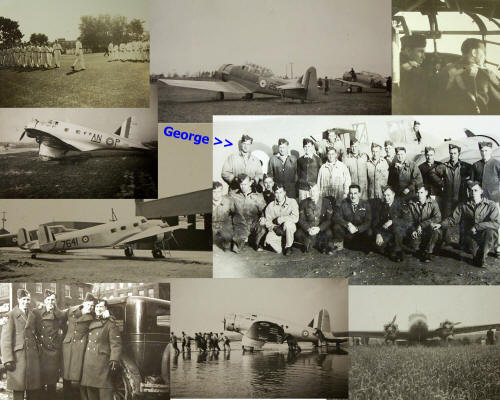
1)
Commonwealth Training in Ontario

2)
Scotland and England
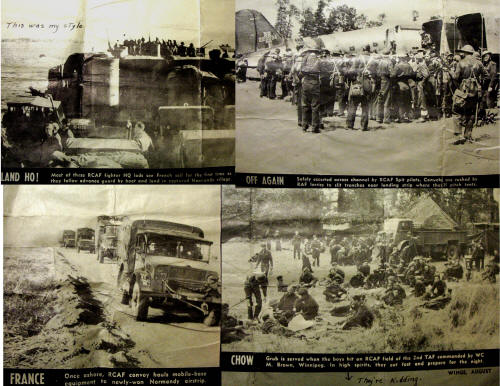
3)
Crossing to Normandy
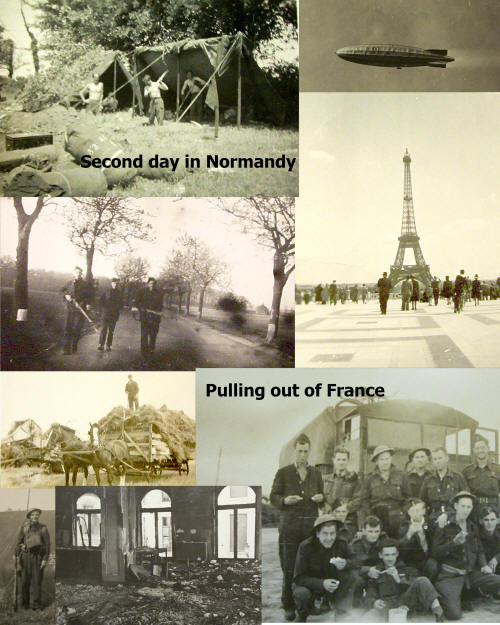
4)
France
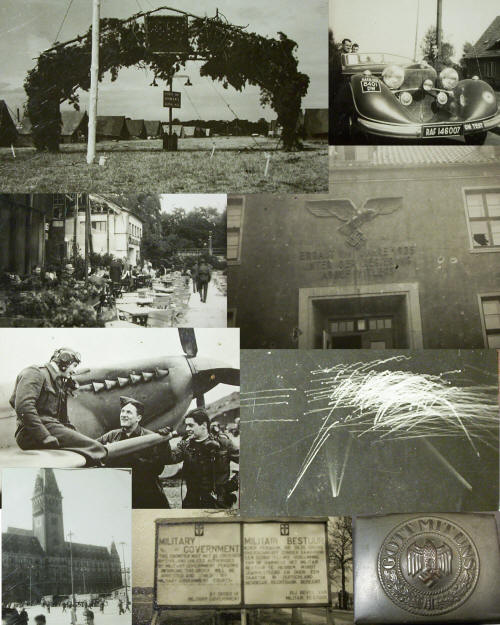
5)
Europe 1

6)
Europe 2
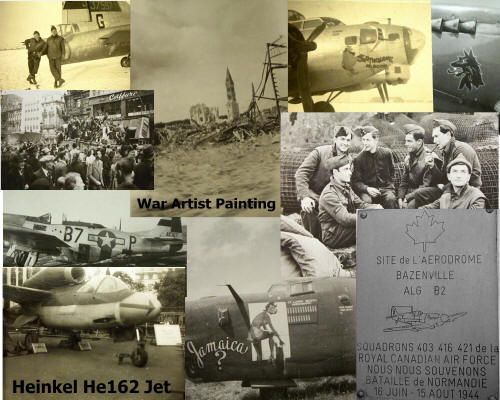
7)
Europe 3
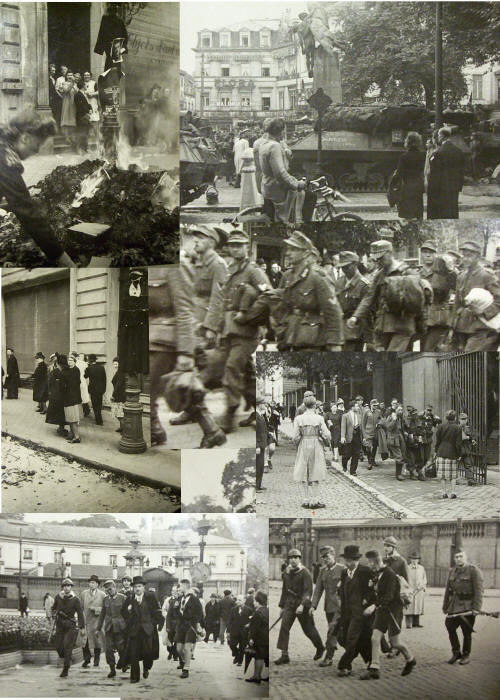
8)
Liberation of Brussels
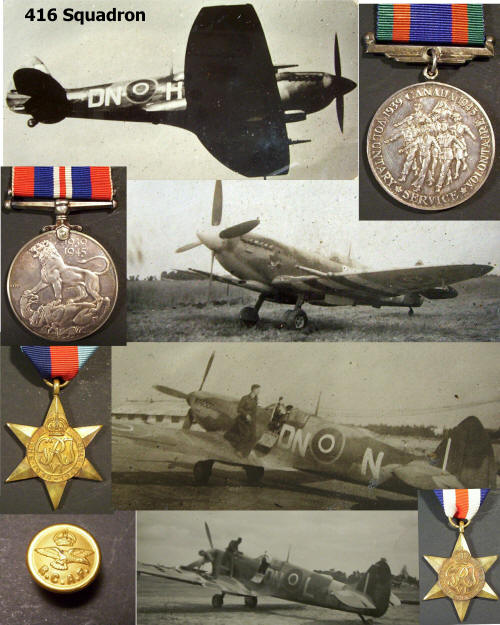
9)
416 Squadron Spitfires
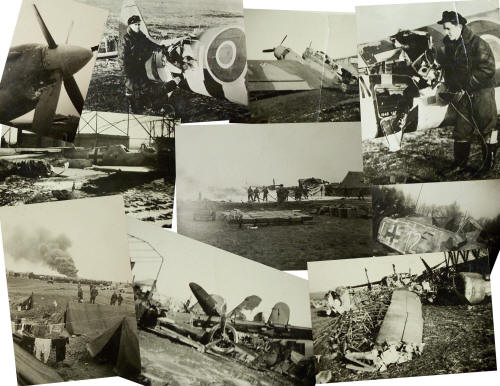
10)
Lest We Forget

11)
416 Squadron Group Shots 1944 |

